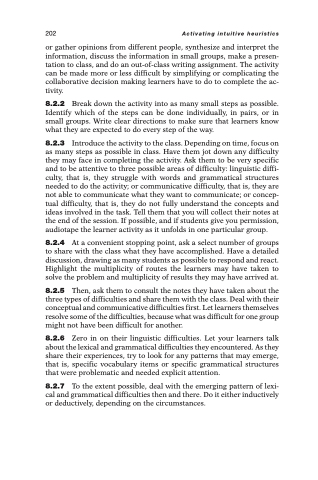Page 214 - Beyond Methods
P. 214
202 Activating intuitive heuristics
or gather opinions from different people, synthesize and interpret the information, discuss the information in small groups, make a presen- tation to class, and do an out-of-class writing assignment. The activity can be made more or less difficult by simplifying or complicating the collaborative decision making learners have to do to complete the ac- tivity.
8.2.2 Break down the activity into as many small steps as possible. Identify which of the steps can be done individually, in pairs, or in small groups. Write clear directions to make sure that learners know what they are expected to do every step of the way.
8.2.3 Introduce the activity to the class. Depending on time, focus on as many steps as possible in class. Have them jot down any difficulty they may face in completing the activity. Ask them to be very specific and to be attentive to three possible areas of difficulty: linguistic diffi- culty, that is, they struggle with words and grammatical structures needed to do the activity; or communicative difficulty, that is, they are not able to communicate what they want to communicate; or concep- tual difficulty, that is, they do not fully understand the concepts and ideas involved in the task. Tell them that you will collect their notes at the end of the session. If possible, and if students give you permission, audiotape the learner activity as it unfolds in one particular group.
8.2.4 At a convenient stopping point, ask a select number of groups to share with the class what they have accomplished. Have a detailed discussion, drawing as many students as possible to respond and react. Highlight the multiplicity of routes the learners may have taken to solve the problem and multiplicity of results they may have arrived at.
8.2.5 Then, ask them to consult the notes they have taken about the three types of difficulties and share them with the class. Deal with their conceptual and communicative difficulties first. Let learners themselves resolve some of the difficulties, because what was difficult for one group might not have been difficult for another.
8.2.6 Zero in on their linguistic difficulties. Let your learners talk about the lexical and grammatical difficulties they encountered. As they share their experiences, try to look for any patterns that may emerge, that is, specific vocabulary items or specific grammatical structures that were problematic and needed explicit attention.
8.2.7 To the extent possible, deal with the emerging pattern of lexi- cal and grammatical difficulties then and there. Do it either inductively or deductively, depending on the circumstances.


